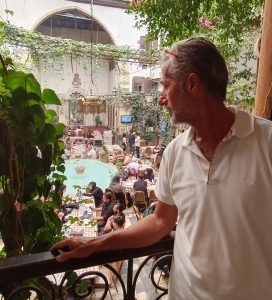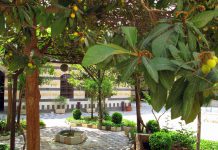Food isn’t just meant to be eaten for the sake of eating in Syria; food is meant to be tasted, enjoyed, even loved. It’s meant to be eaten slowly and, most importantly, fill the stomach.
Food is a staple to the Syrian way of life. It is at the heart of the culture. It’s a way to connect with friends and family; it provides opportunities to socialise, something we love doing. Around it, we might also play board games or cards; listen to music; simply chill; and eat (can’t forget that). We look to have a good time together. And food provides that opportunity.


Traditionally, Syrian hospitality – like that of some other cultures around the world – is such that you are never allowed to go hungry, and there are endless options within the Syrian cuisine.
It offers one of the widest and richest varieties of foods in the world. Its salads, vegetable and meat dishes, legumes, and dishes based around dairy products almost all contain a range of spices, flavours and aromas.
Syrian cuisine was influenced by an infusion of other cultures around the world, hence its rich variety.
‘Mezze’ (or meze or mazza) is the tapas of the Middle East – the starter before the main. Syrian mezze mainly consists of diverse vegetarian or dairy based dips (occasionally meat) and sides which are served and eaten with bread.
This array of dishes, surprisingly perhaps, isn’t only served at cafés or restaurants; it is eaten by Syrians in their own homes for breakfast and lunch (Iftar in Arabic). Of course, it varies slightly. But the list of available choices for the mezze is long.

Syrian mezze can consist of appetisers such as zeit wa zaatar (olive oil with dried oregano), olives, haloumi cheese, hummus (chickpea dip), labaneh (sour yoghurt dip), muhamara (walnut dip), mutabal (eggplant dip), makdous (stuffed pickled eggplant), warak 3anab (stuffed vine leaves), salads such as ful mudamas (bean salad with tomato, cucumber, onions, lemon, and olive oil dressing), fattoush (lettuce, cucumber, tomato, onion, radish, fried pita bread with vinaigrette dressing), savoury pastries such as sfiha (flavoured minced-meat pastries), fatayer bi jibneh (haloumi cheese with parsley filled pastries) falafel (deep-fried ground chickpeas), kibbeh (stuffed mince-meat in bulghur wheat) and many more.

After the mezze come the mains, then the desserts. Traditionally, appetisers followed by the main then a dessert suggests that it’s going to be a long day or night out for Syrians.
In the video above, restauranteur Raed Jabri offers us a simple, but delicious recipe. (Raed Jabri restored and revitalised the Jabri family house in old Damascus, giving it a new lease of life by opening it up to the public as a charming café/restaurant. Beit Jabri was introduced in a previous ‘Beloved Syria’ post.)
As Raed Jabri explains, Beit Jabri serves familiar Damascene dishes, and the simple dish he describes for ‘Beloved Syria’ is usually eaten for breakfast or supper. Considered a traditional Damascene dish, its origin is most likely Greek. The recipe is simple.
Mix white cheese with yoghurt cream. Add green thyme, green onion leaves, slices of onion, and a little sumac. Finally, when it is on a plate, ready to serve, pour a little olive oil on top.

Beit
Enjoy!
!استمتع
























